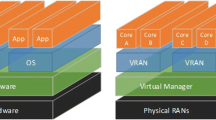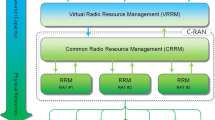Abstract
In future virtual network (VNet) environments, where heterogeneous networks will coexist and new business roles and models are expected, VNets cooperation for radio resource management is one of the key issues in order to achieve an efficient integration of different wireless technologies, while providing the required quality of service. In this paper, an algorithm for Virtual Radio Resource Allocation (VRRA), called OnDemandVRRA, in multiple and heterogeneous virtual networks environment is proposed and discussed. OnDemandVRRA manages the radio resources allocation to the VNets in order to satisfy the VNet contracted capacity. The algorithm has been assessed for two different Virtual scenarios by comparison with a Standard one, in which several network operators have their own networks, each being shared among several mobile virtual network operators. It is shown that the application of OnDemandVRRA to virtualise the wireless access allows achieving better performance from a cluster of several base stations of different radio access technologies, supporting the provision of the contracted capacity for guaranteed VNets, i.e., VNets with a minimum contracted capacity. Globally, it is observed that Virtual scenarios perform better than the Standard one, as the cluster serving data rate may increase by approximately 46 %, if minimum and reference values for the VNet’s contracted capacity have been set. Moreover, in this case, end-users performing best-effort services are served with an average data rate approximately three times higher than in other scenarios, where the reference data rate for the VNet providing these services is not set.











Similar content being viewed by others
Abbreviations
- \(\Delta t_{\textit{TF}}\) :
-
Time frame, the interval of time of the same order of magnitude of the time scale defined for common/joint radio resource management algorithms
- \({\upeta } _{Cl}\) :
-
Cluster Utilisation, ratio between the maximum data rate corresponding to the RUs occupied by end-users and the maximum data rate the cluster can provide
- \(\overline{{\upeta } _{Cl} }\) :
-
Average Cluster Utilisation, the average of the Cluster Utilisation over the total number of time frames in the observation time interval
- \(BS_{\textit{RAT}_i }^{Cl}\) :
-
Set of BSs from various RATs composing a cluster
- \(N_{\textit{RAT}}\) :
-
Total number of RATs in the cluster
- \(N_{\textit{TF}}\) :
-
Total number of time frames over the observation interval
- \(N_{EU}^{BS_j }\) :
-
Number of end-users connected to \({\mathsf{\textit{BS} }}_{\mathsf{\textit{j} }}\)
- \(N_{BS}^{Cl}\) :
-
Total number of BSs within the cluster
- \(N_{EU}^{Cl}\) :
-
Total number of end-users in the cluster
- \(N_{\textit{VBS}}^{Cl}\) :
-
Number of VBSs in the cluster
- \(N_{RU}^{EU_n }\) :
-
Number of RUs assigned to end-user \({\mathsf{\textit{n} }}\)
- \(N_{BS}^{\textit{RAT}_i}\) :
-
Total number of BSs of \({\mathsf{\textit{RAT} }}_{\mathsf{\textit{i} }}\) in the cluster
- \(N_{RU_{{occ}_n}}^{\textit{RAT}}\) :
-
Number of RUs occupied by end-users in each RAT in time frame \({\mathsf{\textit{n} }}\)
- \(N_{RU}^{\textit{RAT}_i}\) :
-
Total number of RUs per BS of RAT \({\mathsf{\textit{i} }}\)
- \(N_{{EUcon}_n}^{\textit{VBS}}\) :
-
Number of end-users connected to the VBS in time frame \({\mathsf{\textit{n} }}\)
- \(\overline{N_{EUcon}^{\textit{VBS}} } \) :
-
Average Number of End-users Connected in each time frame
- \(N_{EU}^{\textit{VBS}_j }\) :
-
Total number of end-users in VBS \({\mathsf{\textit{j} }}\)
- \(p\) :
-
Penalty, the amount the Infrastructure Provider should pay to the MVNO when the VBS is operating out of contract, i.e., when SLAs are not satisfied
- \(\overline{r_{serv}^{\textit{VBS}} }\) :
-
Ratio of Served Data Rate, the relation between the average VBS Serving Data Rate and the average VBS requested data rate
- \(R_{MCSm}\) :
-
Data rate achieved by each RU assigned to the end-user, according to the applied modulation and coding scheme, \({\mathsf{\textit{MCS} }}_{\mathsf{\textit{m} }}\)
- \(R_{serv}^{BS_j}\) :
-
BS Serving Data Rate, the sum of data rates with which the end-users connected to the BS are served
- \(R_{max }^{BS_n }\) :
-
Maximum data rate for BS \({\mathsf{\textit{n} }}\)
- \(R_{max }^{Cl} \) :
-
Maximum Cluster Data Rate is the maximum capacity of the cluster
- \(R_{serv}^{Cl} \) :
-
Cluster Serving Data Rate is the sum of the serving data rates of all BSs composing the cluster
- \(\overline{R_{serv}^{Cl} } \) :
-
Average Cluster Data Rate, the average of the Cluster Serving Data Rate over the total number of time frames in the observation time interval
- \(R_{serv_n }^{EU}\) :
-
End-user Served Data Rate, i.e., the data rate with which end-user \({\mathsf{\textit{n} }}\) is being served
- \(\overline{R_{serv}^{EU} }\) :
-
Average End-user Data Rate, the ratio between the VBS Serving Data Rate and mean end-users connected in each time frame of the observation time interval
- \(R_{RU_{max } }^{\textit{RAT}_i }\) :
-
Data rate the RU of RAT \({\mathsf{\textit{i} }}\) can provide, if the most favourable modulation and coding scheme is applied
- \(R_{req}^{\textit{VBS}_i }\) :
-
VBS Requested Data Rate, i.e., the total data rate requested by end-users in VBS \({\mathsf{\textit{i} }}\)
- \(R_{min }^{\textit{VBS}_j }\) :
-
Minimum Contracted Data Rate, the data rate contracted by the MVNO as the minimum value Infrastructure Providers should provide when requested
- \(R_{ref}^{\textit{VBS}_j }\) :
-
Reference Contracted Data Rate, the data rate contracted by the MVNO as a reference value to be provided by the Infrastructure Providers to the MVNO
- \(R_{serv}^{\textit{VBS}_j }\) :
-
VBS Serving Data Rate, the data rate provided to all end-users connected to the VBS
- \(\overline{R_{serv}^{\textit{VBS}} }\) :
-
Average Serving Data Rate, the average of VBS Serving Data Rate over the total number of time frames in the observation time interval
- \(\textit{RAT}^{Cl}\) :
-
Set of RATs within a cluster
- \(\textit{VBS}^{Cl}\) :
-
Set of VBSs from various VNets created in a cluster
References
Bavier, A., Bowman, M., Chun, B., Culler, D., Karlin, S., Muir, S., et al. (2004). Operating system support for planetary-scale network services. In Proceedings of the USENIX NSDI’04—1st symposium on networked systems design and implementation, San Francisco, CA, USA.
Sanjoy, P., & Srini, S. (2006). GENI: Global Environment for Network Innovations, technical document on wireless virtualisation, GENI project, Wireless Working Group, Document GDD-06-17. http://www.geni.net
Schaffrath, G., Werle, C., Papadimitriou, P., Feldmann, A., Bless, R., Greenhalgh, A., et al. (2009). Network virtualisation architecture: Proposal and initial prototype. In Proceedings of the VISA’09—1st ACM SIGCOMM workshop on virtualized infrastructure systems and architectures, Barcelona, Spain.
Zhu, Y., Zhang-Shen, R., Rangarajan, S., & Rexford, J. (2008). Cabernet: Connectivity architecture for better network services. In Proceedings of the ReArch’08—ACM workshop on re-architecting the internet, Madrid, Spain.
Anderson, T., Peterson, L., Shenker, S., & Turner, J. (2005). Overcoming the internet impasse through virtualisation. IEEE Computer Magazine, 38(4), 34–41.
Sachs, J., & Baucke, S. (2008). Virtual radio: A framework for configurable radio networks. In Proceedings of the WICON’08—4th annual international conference on wireless internet, Maui, HI, USA.
Hu, S., Yao, Y., & Yang, Z. (2012). MAC protocol identification approach for implement smart cognitive radio. In Proceedings of the ICC 2012—IEEE international conference on communications, Ottawa, Canada.
3GPP. (2013). 3GPP technical specification universal mobile telecommunications system (UMTS); LTE; network sharing; architecture and functional description (Release 11), Technical Specification TS 23.251 V11.4.0. http://www.3gpp.org
Alcatel-Lucent. (2012). Network sharing in LTE: Opportunities & solutions, Technology White Paper. http://alcatellucentmediaroom.files.wordpress.com/2010/07/lte_network_sharing_en_techwhitepaper1.pdf
Zaki, Y., Liang, Z., Goerg, C., & Timm-Giel, A. (2010). LTE wireless virtualisation and spectrum management. In Proceedings of the WMNC’10—Wireless and mobile networking conference, Budapest, Hungary.
Bhanage, G., Seskar, I., Mahindra, R., & Raychaudhuri, D. (2010). Virtual basestation: Architecture for an open shared WiMAX framework. In Proceedings of the VISA’10—Virtualized infrastructure systems and architectures, New Delhi, India.
Kokku, R., Mahindra, R., Zhang, H., & Rangarajan, S. (2013). Cellular wireless resource slicing for active RAN sharing. In Proceedings of the COMSNETS 2013—5th international conference on communication systems and networks, Bangalore, India.
Bhanage, G., Vete, D., Seskar, I., & Raychaudhuri, D. (2010). SplitAP: Leveraging wireless network virtualisation for flexible sharing of WLANs. In Proceedings of the GLOBECOM 2010—Global communication conference, Miami, FL, USA.
Xia, L., Kumar, S., Yang, X., Gopalakrishnan, P., Liu, Y., Schoenberg, S., et al. (2011). Virtual WiFi: Bring virtualisation from wired to wireless. In Proceedings of the VEE’11—International conference on virtual execution environments, Newport Beach, CA, USA.
Caeiro, L., Cardoso, F. D., & Correia, L. M. (2012). OConS supported on demand radio resource allocation for virtual connectivity. In Proceedings of the MONAMI—4th international conference on mobile networks and management, Hamburg, Germany.
IEEE. (2005). IEEE standard for local and metropolitan area networks: Virtual bridged local area networks, 802.1 WG, IEEE Std. 802.1Q-2005. http://standards.ieee.org/getieee802/download/802.1Q-2005.pdf
Cisco Systems. (2012). Cisco Visual Networking Index: Global mobile data traffic forecast update, 2011–2016, Cisco\({\textregistered }\) Visual Networking Index (VNI). http://www.cisco.com
Acknowledgments
The support of the European Commission by partially funding this work via the FP7-ICT-2009-5—SAIL project, Grant Agreement Number 257448, is acknowledged.
Author information
Authors and Affiliations
Corresponding author
Rights and permissions
About this article
Cite this article
Caeiro, L., Cardoso, F.D. & Correia, L.M. OnDemand Virtual Radio Resource Allocation for Wireless Access. Wireless Pers Commun 82, 2431–2456 (2015). https://doi.org/10.1007/s11277-015-2357-7
Published:
Issue Date:
DOI: https://doi.org/10.1007/s11277-015-2357-7




